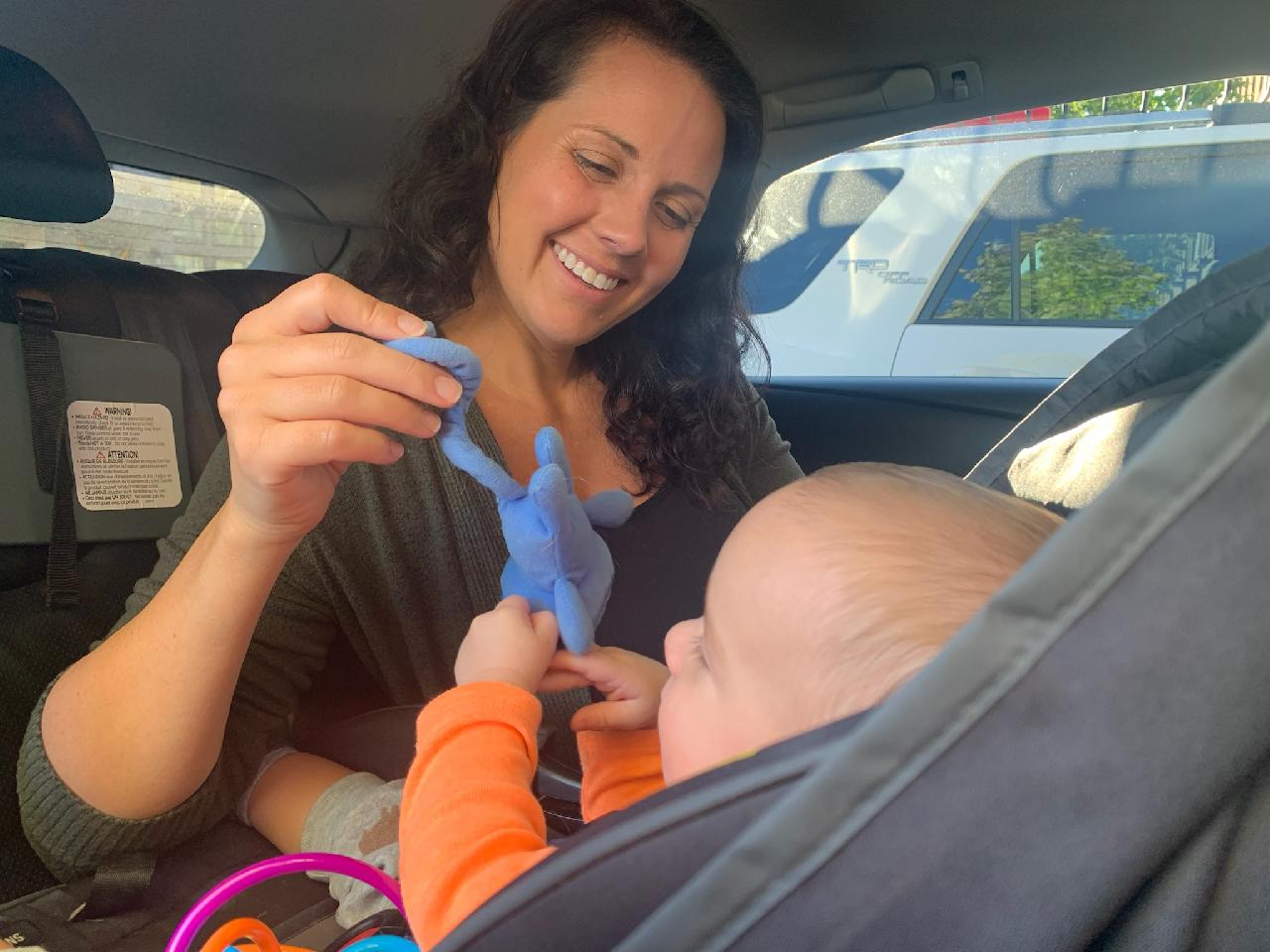
Successful travel with a baby is possible without using a device for distraction. Child development experts explain why tech-free travel is a boost to a baby’s brain, psyche, and relationship with you.
My daughter Shannon, her 5-month-old son, and I had just finished a successful 8-hour car trip south and back. It wasn’t always easy, but we cajoled Cooper with chatter, songs, books and toys—none of which had a cord or battery.
The best moment was on our ride back home.
It was pitch dark when Cooper began to howl. We’d been driving for hours and I thought we were out of ideas, but Shannon had one more. She began to “read” The Very Hungry Caterpillar—completely from memory. Softly and gently, like so many times before, she recited every page.
Coop soon quieted down and was asleep before the caterpillar became a butterfly.
A few days later, Shannon clicked on a YouTube video claiming to have the inside scoop on how to travel with a baby. As she recalls:
“First, the mom-fluencer, who was sitting in the back seat, showed her husband up front behind the wheel. Then the mom panned a little bit further to reveal an iPad, already playing a video, secured by a plastic case fastened to the back seat about a foot in front of the baby’s face. I had to laugh. Ohhh. That’s the big secret?”
Why Parents Turn to Tablets
Although our trip was sans tech, Shannon considered the alternative.
“I completely understand the allure of having a tablet or smartphone on autoplay for the duration,” she mused.
“Screens are literally mesmerizing to kids, which will almost certainly keep them zoned in or lull them to sleep within moments. Plus, there’s more enticing entertainment out there than ever, and a lot of it seems to be educational. Pressing play on the iPad is a no brainer for you and frees you up to do other things.”
What Babies Really Need
What is best for baby when it comes to travel? I consulted two experts.
Alice Hanscam lives in Alaska. Her passion for kids extends for 40 years as a preschool teacher, parent coach, and author of multiple books and articles.

Alice Hanscam
Alyssa Loberti is a Rhode Island speech-language pathologist who works with very young pre- or minimally-verbal children. In her work, she uses a “total communication, family-centered” approach.

Alyssa Loberti
Both experts remind us that we grownups are used to travel, but everything is new to a baby.
Alice ticks through the list: “the natural gazing out of the window, watching the reflection of lights and colors go by, the sounds.” All are lost when a device is on.
“Now a child is staring at only the screen, is less tuned into their current experience, losing out on all the natural and essential learning it offers, and is being ‘told’ what to look at and think about,” she explains.
The Isolated Child
Alyssa understands that drivers need to watch the road, but worries about “the isolated child.”
“Rather than allowing the child to be in the experience with everyone else in the car, you have created an isolated experience where the child is doing something else. That means the baby is not in sync with the rest of the people in the car and not in tune with any talk and conversation.”
She thinks back to what babies did before iPads. “They played with their feet…made noises so the parents in the front seat could talk back…they mouthed things…they blew raspberries….they looked at a sibling sitting in the back seat.”
Babies still need those simple, full-sensory activities—even in a car.
Devices “interrupt crucial interactions babies require for growing well, with a responsive, tuned in parent, talking, singing, answering baby’s needs,” adds Alice.
Screens Stress Babies
Images on a screen really do mesmerize babies. Research shows they literally can’t look away. Falling asleep is one of their very few ways to avoid the non-stop high-intensity content.
“How frustrating that must be as they feel done with the constant input yet unable to control it,” Alice sympathizes.
You’re also not “there” for them when they’re upset.
“Think of the now-overwhelmed baby in their car seat with a screen on in front of them,” says Alice. “All their initial cues of ‘too much!’ were not responded to. Now baby feels more stress, which interrupts their feeling the deep connection with us that is necessary for healthy growth—emotionally and physically.”
Embracing Boredom
Distraction with a screen interferes with a baby’s chance to learn the vital skill of “doing nothing.”
“Having a device on does not allow the child a chance to get bored and do things that we may have done back in the day before devices, such as look at cars, street signs, people walking, and the lights change,” says Alyssa.
Our job as parents is to grow confident travelers who are in tune with what’s going on around them.
“The gift you are giving is building a foundation for successful (and screen-free) future trips as you have a toddler, preschooler, or older child happily engaged with the books, treats, little games you bring with you,” adds Alice.
Birth of a Bad Habit
Once you start handing over a device, it becomes very easy. The experts both agree that using technology to quiet down infants can work in the moment, but set both of you up for problems later.
A parent who relies on a device to pacify a baby, says Alyssa, “tends to feed into having and needing it for them as they grow, rather than having them experience the travel and all it offers; having them learn how to self-soothe, to be okay thinking their own thoughts.
When the child then gets out of the car, I suspect the parent is then giving it to them in the stroller… at the restaurant… at the doctor’s office waiting room… EVERYWHERE.”
“Use of screens really is saying, ‘You need this in order to be okay,’” adds Alice, “and tends to undermine a child’s ability to live and act from the inside-out—in charge of themselves, feeling capable and competent.”
Shannon also makes the point that “it may hurt their staying power when it comes to sitting through something that they can’t virtually check out of, like class, church, or even dinner with the family.”
Babies who get in the habit of watching screens several hours a day are also at risk for the newly-identified developmental disorder known as Virtual Autism, described in detail here.

Preparing for Travel with Baby
Like anything worthwhile, travel with a baby takes some forethought and preparation. Basics from the experts to keep in mind:
Keep it Fresh
Pack a go-bag bag with non-screen-based toys that only goes with you in the car, to a restaurant, etc. That way, says Alyssa, “the items remain novel. You can go to the dollar store and make a whole bag of things for five to ten dollars!”
Take care of baby’s needs before you leave
Be sure to change, feed, and otherwise attend to your baby’s needs before you go, says Alice. “It can be easier to hear your baby fuss or even cry as you attend to travel needs that require your full attention.”
Use your words to transition from home to travel with baby
As you prepare for the trip and head for the car, tell the baby what you’re doing. “Say something like ‘I’m going to buckle you into your seat now so we can drive to the store! Are you ready?’ suggests Alice.
“The more familiar they are with a calm and predictable process, the more comfortable they become.”
Give baby a seat partner
Have someone sit in the back near the baby, if possible. “When babies are rear-facing, especially, you are set up perfectly face-to-face with your baby,” Shannon recalls.
“All you have to do is stare at each other and smile. You can mirror their babbling, sing them songs or tell stories, and major bonding occurs, which doesn’t happen if both of you are tuned into screens instead of each other.”
Build in time for stops
While you’re on the road your baby’s little body will remain on the same schedule as usual. Know from the get-go your trip will take longer because of stops for diaper changes, feedings, or simply to give them a break from the carseat.
Keep in mind that the World Health Organization recommends that children under age one in ordinary circumstances should not be restrained for more than an hour at a time. WHO guidance also recommends babies should not be around screens at all except for the occasional video call when you are present.
Know baby’s gonna cry
Babies cry as a way to communicate since they don’t have words. Therefore, says Alice: “Know that it is okay if baby fusses!”
In fact, she says, it’s a growthful experience for you and your baby. “Calming yourself and growing your ability to be okay even when your little one is not is an essential skill needed all along our parenting journey! It actually provides our upset little one with a safe space in which to BE upset.
Trust your Intuition
We are used to relying on devices, but in this case, a tablet can’t substitute for you.
“Talking and singing to baby is very soothing and comforting,” says Alice. “Trust this.
Hearing a parent’s comforting voice at these times is far more impactful and essential than distraction by a screen—and far more supportive of growing a healthy brain.”
Alyssa agrees. “You’re helping the baby realize they are still safe and can check in with a caregiver, even from a distance (when you’re behind the wheel).”
Sometimes you just gotta vamp
Shannon discovered that gentle gusts of wind could bring Cooper out of a funk.
One time, he calmed down when she directed a hand-held electric fan (set on low) toward his face. Another time, she lowered the car window a bit and he stopped crying and listened to the sound of the rushing air.
And when all else fails, sing! Coop was at the end of his rope and a spirited round of “99 Bottles of Beer on the Wall” got us all to the next rest stop.
Essential Items for Travel with Baby
This list comes from my daughter’s and my experience and the experts’ ideas. Try to bring along:
- Unbreakable Travel Mirror – attaches to rear seat headrest so driver can see baby
- Window shade (in case of sun directly in baby’s eyes)
- Familiar object like a cuddly blanket or stuffed animal
- Variety of toys, such as those that:
 Are soft and easy to hold (with multiple surfaces to feel, if possible!)
Are soft and easy to hold (with multiple surfaces to feel, if possible!)
 Rattle or crinkle when baby squeezes
Rattle or crinkle when baby squeezes
 Can be sucked and chewed, such as a teether or pacifier
Can be sucked and chewed, such as a teether or pacifier
 Attach to the car seat (so they’re harder to drop out of reach)
Attach to the car seat (so they’re harder to drop out of reach)
- Baby board books
- Change of clothes
- Gear for colder weather, such as outerwear and blanket
- Formula and bottles (for emergencies, even if you breastfeed)
- Items for you, including snacks, water, other self-care objects
Your Precious Wild Human
Keep in mind you’re carrying precious and rarified cargo: a Wild Human.
As I write in The Durable Human Manifesto:
Today’s newborns are just like those who came before them— they’re as wild and untethered as the squirrels in the trees.
Early childhood is a once-in-lifetime opportunity. It’s the only time in life a person can focus full time on getting to know his or her own onboard operating system (read: their body and mind). They have the rest of their lives to plug into the digital world.
In the end, Shannon says she’ll continue to travel with Coop sans tech: “Even if you don’t have two drivers, you still might want to consider giving your baby a chance to allow her senses to actively take in everything about the trip, rather than just numbing out.”
Her thoughts apply to parenting in general.
“A road trip is an opportunity to learn about your baby through problem-solving, and trial and error. What are their nuances and quirks when they are feeling fussy? What works and what doesn’t? You aren’t really forced to tune into these clues or use the extent of your creativity if you’re just vacillating from iPad to feeding to dirty diaper and back to iPad again.
Yes, sometimes I feel like a one-woman circus and it’s exhausting, but for me—and for my baby’s developing brain—it’s worth it!”
About the author:
Jenifer Joy Madden is a Syracuse University adjunct professor of digital journalism, a certified digital wellness instructor, the founder of DurableHuman.com, and proud parent of three practicing durable humans.



